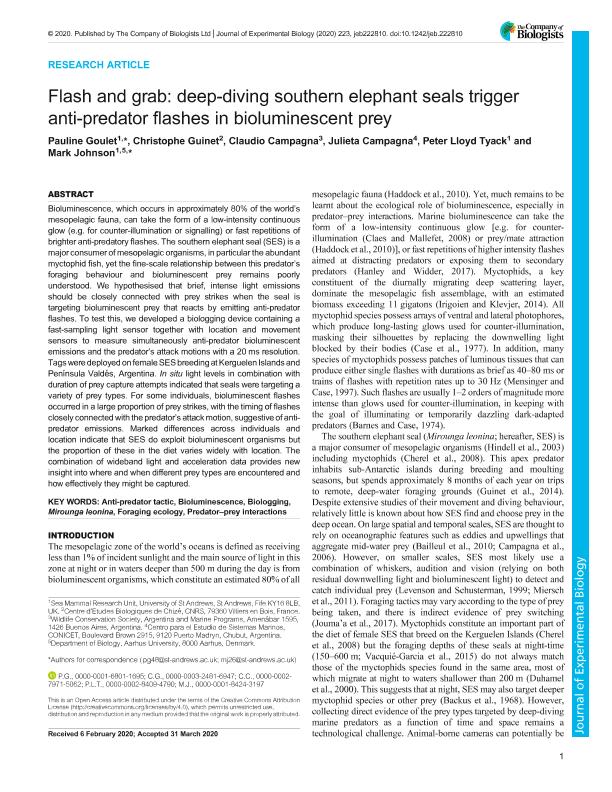Mostrar el registro sencillo del ítem
dc.contributor.author
Goulet, Pauline
dc.contributor.author
Guinet, Christophe
dc.contributor.author
Campagna, Claudio

dc.contributor.author
Campagna, Julieta

dc.contributor.author
Tyack, Peter Lloyd
dc.contributor.author
Johnson, Mark
dc.date.available
2021-01-12T20:23:02Z
dc.date.issued
2020-05
dc.identifier.citation
Goulet, Pauline; Guinet, Christophe; Campagna, Claudio; Campagna, Julieta; Tyack, Peter Lloyd; et al.; Flash and grab: Deep-diving southern elephant seals trigger anti-predator flashes in bioluminescent prey; Company of Biologists; Journal of Experimental Biology; 223; 10; 5-2020; 1-11
dc.identifier.issn
0022-0949
dc.identifier.uri
http://hdl.handle.net/11336/122552
dc.description.abstract
Bioluminescence, which occurs in approximately 80% of the world's mesopelagic fauna, can take the form of a low-intensity continuous glow (e.g. for counter-illumination or signalling) or fast repetitions of brighter anti-predatory flashes. The southern elephant seal (SES) is a major consumer of mesopelagic organisms, in particular the abundant myctophid fish, yet the fine-scale relationship between this predator's foraging behaviour and bioluminescent prey remains poorly understood. We hypothesised that brief, intense light emissions should be closely connected with prey strikes when the seal is targeting bioluminescent prey that reacts by emitting anti-predator flashes. To test this, we developed a biologging device containing a fast-sampling light sensor together with location and movement sensors to measure simultaneously anti-predator bioluminescent emissions and the predator's attack motions with a 20 ms resolution. Tags were deployed on female SES breeding at Kerguelen Islands and Peninsula Valdés, Argentina. In situ light levels in combination with duration of prey capture attempts indicated that seals were targeting a variety of prey types. For some individuals, bioluminescent flashes occurred in a large proportion of prey strikes, with the timing of flashes closely connected with the predator's attack motion, suggestive of antipredator emissions. Marked differences across individuals and location indicate that SES do exploit bioluminescent organisms but the proportion of these in the diet varies widely with location. The combination of wideband light and acceleration data provides new insight into where and when different prey types are encountered and how effectively they might be captured.
dc.format
application/pdf
dc.language.iso
eng
dc.publisher
Company of Biologists

dc.rights
info:eu-repo/semantics/openAccess
dc.rights.uri
https://creativecommons.org/licenses/by-nc-sa/2.5/ar/
dc.subject
ANTI-PREDATOR TACTIC
dc.subject
BIOLUMINESCENCE
dc.subject
BIOLOGGING
dc.subject
MIROUNGA LEONINA
dc.subject
FORAGING ECOLOGY
dc.subject
PREDATOR–PREY INTERACTIONS
dc.subject.classification
Ecología

dc.subject.classification
Ciencias Biológicas

dc.subject.classification
CIENCIAS NATURALES Y EXACTAS

dc.title
Flash and grab: Deep-diving southern elephant seals trigger anti-predator flashes in bioluminescent prey
dc.type
info:eu-repo/semantics/article
dc.type
info:ar-repo/semantics/artículo
dc.type
info:eu-repo/semantics/publishedVersion
dc.date.updated
2020-12-04T14:47:47Z
dc.journal.volume
223
dc.journal.number
10
dc.journal.pagination
1-11
dc.journal.pais
Reino Unido

dc.journal.ciudad
Cambridge
dc.conicet.avisoEditorial
This is an Open Access article distributed under the terms of the Creative Commons Attribution License (http://creativecommons.org/licenses/by/4.0), which permits unrestricted use, distribution and reproduction in any medium provided that the original work is properly attributed.
dc.description.fil
Fil: Goulet, Pauline. University of St. Andrews; Reino Unido
dc.description.fil
Fil: Guinet, Christophe. Centre National de la Recherche Scientifique; Francia
dc.description.fil
Fil: Campagna, Claudio. Wildlife Conservation Society; Argentina
dc.description.fil
Fil: Campagna, Julieta. Consejo Nacional de Investigaciones Científicas y Técnicas. Centro Científico Tecnológico Conicet - Centro Nacional Patagónico. Centro para el Estudio de Sistemas Marinos; Argentina
dc.description.fil
Fil: Tyack, Peter Lloyd. University of St. Andrews; Reino Unido
dc.description.fil
Fil: Johnson, Mark. University of St. Andrews; Reino Unido. University Aarhus; Dinamarca
dc.journal.title
Journal of Experimental Biology

dc.relation.alternativeid
info:eu-repo/semantics/altIdentifier/doi/https://doi.org/10.1242/jeb.222810
dc.relation.alternativeid
info:eu-repo/semantics/altIdentifier/url/https://jeb.biologists.org/content/223/10/jeb222810
Archivos asociados
